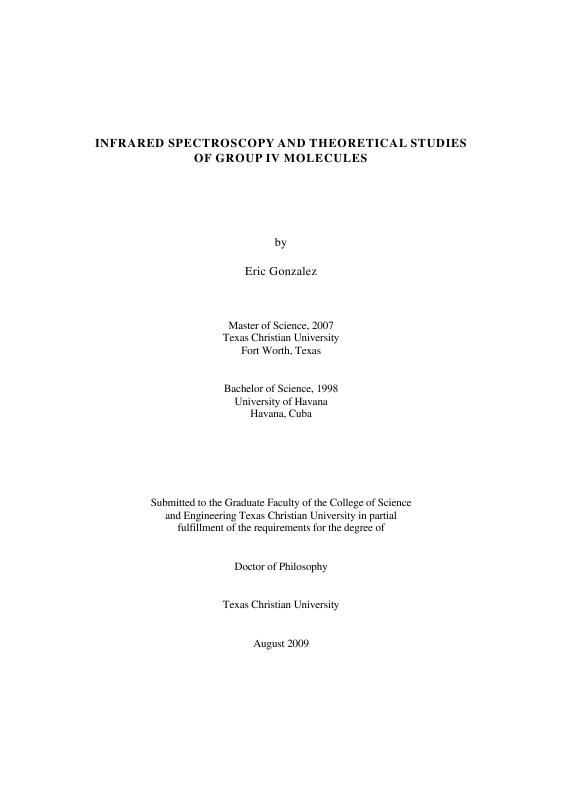Infrared spectroscopy and theoretical studies of group IV moleculesShow full item record
| Title | Infrared spectroscopy and theoretical studies of group IV molecules |
|---|---|
| Author | Gonzalez, Eric |
| Date | 2009 |
| Genre | Dissertation |
| Degree | Doctor of Philosophy |
| Abstract | This research involved the formation of novel molecules, and the first observation of infrared active modes and infrared active combination bands of already discovered molecules. The molecules were produced by the laser evaporation of germanium, germanium-carbon, and carbons rod previously sintered in a new built vacuum furnace. The infrared spectra were taken using Bomem FTIR spectrometer with an interface infrared optics toward the formation chamber. These molecules were theoretically simulated using commercial quantum chemistry suites of programs and homemade codes. The linear GeC5Ge germanium-carbon chain has been detected for the first time through the dual laser evaporation of graphite and germanium, the ?4(su) vibrational fundamental was observed at 2158.0 cm-1. Two new vibrational fundamentals of linear GeC3Ge, ?4(su = 735.3 cm-1 and ?6(pu) = 580.1 cm-1, have been observed.^This is apparently the first observation of germanium isotopic shifts in vibrational spectra.^Linear GeC3 has been formed by the dual laser ablation of germanium and carbon rods and by single laser ablation of a sintered germanium-carbon rod, and trapped in Ar matrices. Two vibrational fundamentals of linear GeC3, ?1(s) = 1903.9 cm-1 and ?2(s) = 1279.6 cm-1, have been observed. In the present work there is no spectroscopic evidence of cyclic structures for GeC3 with either the transannular Ge-C or C-C bond although at the coupled cluster level of theory they are both predicted to be ~7-9 kcal/mol lower in energy than the linear isomer. This result suggests a need for further theoretical studies of GeC3 to see if the cyclic isomers are indeed more stable than the linear.^New combination bands of carbon chains have been observed, (?1+?4) = 3388.8 cm-1 of linear C5 and (?2+?7) = 3471.8 cm-1 of linear C9.^Since the asymmetric stretching1 modes involved in these absorptions have been measured previously it has been possible to assign the infrared inactive symmetric stretching modes, the ?1(sg) mode of linear C5 at 1942 cm-1 and the ?2(sg) mode of linear C9 at 1870 cm-1. The ?1(sg) mode of linear C5 is the last undetected fundamental of this molecule. The ?6(su) weakest asymmetric stretching mode of linear C7 has been detected for the first time and has been assigned at 1100.1 cm-1 in solid Ar.^The calculation of the intensities of combination bands presented in this work suggests that the second derivatives computed numerically from the first derivatives are precise enough to predict intensities of combination/difference bands with magnitudes of order >~5 km/mol.^Therefore, computing the fundamentals intensities using the mechanical (up to the quartic term) and electrical (up to the second term) anharmonicity corrections might clarify why the intensity predictions using only the first dipole-moment derivatives with pure harmonic states are so inexact. To my knowledge, the inexactness of the calculated fundamental intensities is attributed to the method used for the calculation of the first derivatives of the dipole-moment rather than including anharmonic terms. |
| Link | https://repository.tcu.edu/handle/116099117/4139 |
| Department | Physics and Astronomy |
| Advisor | Graham, W. R. M. |
Files in this item
This item appears in the following Collection(s)
- Doctoral Dissertations [1523]
© TCU Library 2015 | Contact Special Collections |
HTML Sitemap



